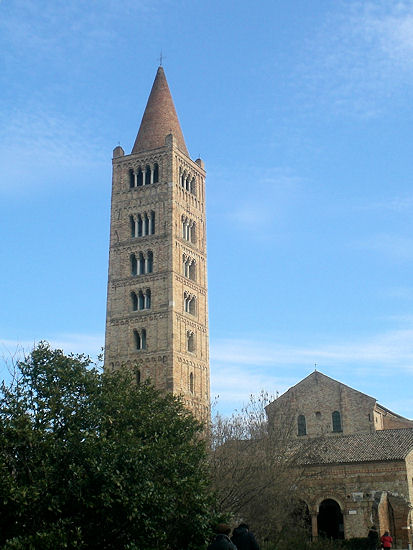|
The Abbey rises along the “Strada Romea”, the ancient way of pilgrims, in the short stretch between the Po of Goro and the Po of Volano.
The first community settled in this area, in the past completely surrounded by waters, around 6th -7th century by Saint Columbanus’ monks.
Starting from 9th century a smaller Benedictine Abbey is mentioned.
The present abbey was consecrated in 1026 and enjoyed golden ages; up to 14th century its possessions spread over the surroundings and several other Italian places, thanks to the conspicuous donations.
Also thanks to the job of the amanuensis of this abbey the culture could be preserved and spread during the Middle Ages. Just here the monk Guido d’Arezzo invented the modern musical notes.
The decline was progressive and due to several causes: poor management by some abbots, greed of feudatories, infightings in the Church.
But also geographic and environmental causes (as malaria and growing marshlands) had a great influence on the decay.
Just here during his stay in 1321 Dante contracted the disease that drove him to death.
In 1653 Pope Innocenzo X suppressed the monastery, that in 1802 was acquired by the Ravenna family Guiccioli.
At the end of 19th century the property was transferred to Italian State.
|
|
The oldest part of Saint Mary Church dates back to 7th -9th century and in 11th century it was enlarged. The interior has a nave and two aisles, divided by Roman and Byzantine columns.
The marble floor in “opus sectile” [1] was made during different times (from 6th to 12th century); the walls are decorated by 13th century frescoes of the Bologna school, with stories of the Old and New Testament and the Apocalypse while on the counter-façade there is the Last Judgement. In the apse there are frescoes due to Vitale da Bologna.
The bell-tower dates back to 1063 (157 ft) in compliance to the Lombard style.
Toward the top the windows increase and widen following the style of that period with the aim of lightening the weight of the tower and better spreading the sound of the bells.
Of the monastery remain the chapter House with frescoes of the beginning of 14th century due to Giotto’s workshop and the refectory with the most precious frescoes of the abbey attributed to a Rimini master.
To be noted also the palazzo della Ragione.
[1] It refers to a refined and very difficult art technique of the ancient and medieval Roman world where materials were cut and inlaid into walls and floors to make a picture or pattern. The materials used were rare marbles, mother of pearl, and glass.
Thanks to our friend Giulio Pettenò for the material of this special report. |






















































